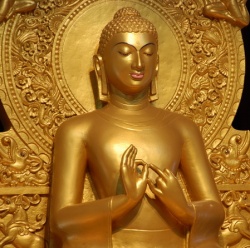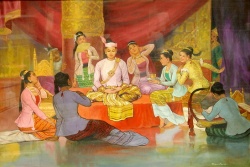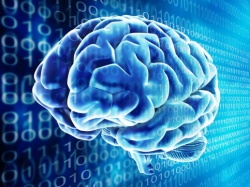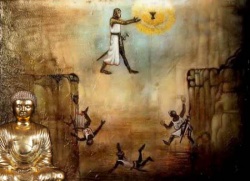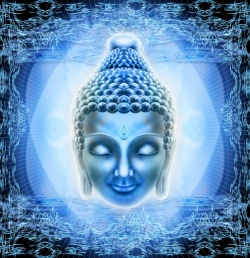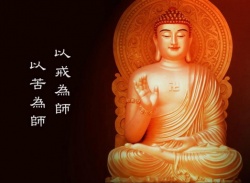Difference between revisions of "The Five Sheaths (Koshas)."
(Created page with " In the body there are five kosha or sheaths: Anna-maya, prana-maya, mano-maya, vijñana-maya, ananda-maya, or the physical and vital bodies, the two...") |
|||
| Line 1: | Line 1: | ||
| + | <nomobile>{{DisplayImages|214|951|1737|2524|3639|4431|4472|1169}}</nomobile> | ||
| + | In the [[body]] there are five [[kosha]] or sheaths: [[Anna-maya]], [[prana-maya]], [[mano-maya]], [[vijñana-maya]], [[ananda-maya]], | ||
| − | + | or the [[physical]] and [[vital bodies]], the two [[mental bodies]], and the [[body of bliss]]. | |
| − | + | In the first the Lord is self-conscious as being dark or fair, short or tall, old or youthful. | |
In the [[vital body]] He [[feels]] alive, hungry, and thirsty. In the [[mental]] [[bodies]] He [[thinks]] and [[understands]]. | In the [[vital body]] He [[feels]] alive, hungry, and thirsty. In the [[mental]] [[bodies]] He [[thinks]] and [[understands]]. | ||
| − | And in the [[body]] of [[Bliss]] He resides in [[happiness]] | + | And in the [[body]] of [[Bliss]] He resides in [[happiness]]. |
| + | Thus garmented with the five garments, the Lord, though all pervading, appears as though He were limited by them. | ||
| − | |||
| + | ==[[Anna-Maya Kosha]]== | ||
| − | |||
| − | The two former produce [[food]] and drink, which is assimilated by the [[fire]] of {{Wiki|digestion}}, and converted into the [[body]] of [[food]]. The [[indriya]] are both the {{Wiki|faculty}} and {{Wiki|organs}} of [[sense]]. | + | In the [[material body]], which is called the "sheath of [[food]]" ([[anna-maya kosha]]), reign the [[elements]] [[earth]], [[water]], and [[fire]], which are those presiding in the [[lowest Chakra]], the [[Muladhara]], [[Svadhishthana]], and [[mani-pura]] centres. |
| + | |||
| + | The two former produce [[food]] and drink, which is assimilated by the [[fire]] of {{Wiki|digestion}}, and converted into the [[body]] of [[food]]. | ||
| + | |||
| + | The [[indriya]] are both the {{Wiki|faculty}} and {{Wiki|organs}} of [[sense]]. | ||
There are in this [[body]] the material {{Wiki|organs}}, as {{Wiki|distinguished}} from the {{Wiki|faculty}} of [[sense]]. | There are in this [[body]] the material {{Wiki|organs}}, as {{Wiki|distinguished}} from the {{Wiki|faculty}} of [[sense]]. | ||
| − | In the | + | In the [[gross body]] ([[sharira-kosha]]) there are six external [[kosha]], viz., [[hair]], {{Wiki|blood}}, flesh, which come from the mother, and bone, muscle, marrow, from the father. |
The {{Wiki|organs}} of [[sense]] ([[indriya]]) are of two kinds, viz.: | The {{Wiki|organs}} of [[sense]] ([[indriya]]) are of two kinds, viz.: | ||
| − | jnanendriya, or {{Wiki|organs}} of [[sensation]], through which [[knowledge]] of the [[external world]] is obtained ({{Wiki|ear}}, {{Wiki|skin}}, [[eyes]], {{Wiki|tongue}}, {{Wiki|nose}}); and [[karmendriya]], or {{Wiki|organs}} of [[action]], {{Wiki|mouth}}, arms, {{Wiki|legs}}, anus, {{Wiki|penis}}, the functions of which are {{Wiki|speech}}, holding, walking, {{Wiki|excretion}}, and procreation. | + | [[jnanendriya]], or {{Wiki|organs}} of [[sensation]], through which [[knowledge]] of the [[external world]] is obtained ({{Wiki|ear}}, {{Wiki|skin}}, [[eyes]], {{Wiki|tongue}}, {{Wiki|nose}}); and [[karmendriya]], or {{Wiki|organs}} of [[action]], {{Wiki|mouth}}, arms, {{Wiki|legs}}, anus, {{Wiki|penis}}, the functions of which are {{Wiki|speech}}, holding, walking, {{Wiki|excretion}}, and procreation. |
| + | |||
| + | |||
| + | ==[[Prana-Maya Kosha]]== | ||
| − | + | The second sheath is the [[prana-maya-kosha]], or sheath of "[[breath]]" ([[prana]]), which [[manifests]] itself in [[air]] and {{Wiki|ether}}, the presiding [[elements]] in the [[Anahata]] and [[Vishuddha chakra]]. | |
| − | |||
| + | There are ten {{Wiki|vayu}} (airs), or [[inner vital forces]], of which the first five are the [[principal]], namely, | ||
| + | <poem> | ||
| + | the {{Wiki|sapphire}} [[prana]]; | ||
| + | [[apana]], the {{Wiki|colour}} of an evening cloud; | ||
| + | the {{Wiki|silver}} [[vyana]]; | ||
| + | [[udana]], the {{Wiki|colour}} of [[fire]]; | ||
| + | and the milky [[samana]]. | ||
| + | </poem> | ||
| − | + | These are all aspects of the [[action]] of the one [[Prana-devata]]. | |
| − | + | [[Kundalini]] is the Mother of [[prana]], which She the [[Mula-Prakriti]], illumined by the {{Wiki|light}} of the Supreme [[Atma]], generates. | |
[[Prana]] is {{Wiki|vayu}}, or the [[universal]] force of [[activity]], divided on entering each {{Wiki|individual}} into fivefold function. | [[Prana]] is {{Wiki|vayu}}, or the [[universal]] force of [[activity]], divided on entering each {{Wiki|individual}} into fivefold function. | ||
| Line 45: | Line 61: | ||
Specifically considered, [[prana]] is inspiration, which with expiration is from and to a distance of eight and twelve inches respectively. | Specifically considered, [[prana]] is inspiration, which with expiration is from and to a distance of eight and twelve inches respectively. | ||
| − | [[Udana]] is the ascending {{Wiki|vayu}}. [[Apana]] is the downward {{Wiki|vayu}}, expelling [[wind]], excrement, {{Wiki|urine}}, and semen. The [[samana]], or collective {{Wiki|vayu}}, kindles the [[bodily]] [[fire]], "conducting equally the [[food]], etc., throughout the [[body]]." | + | [[Udana]] is the ascending {{Wiki|vayu}}. [[Apana]] is the downward {{Wiki|vayu}}, expelling [[wind]], excrement, {{Wiki|urine}}, and semen. |
| + | |||
| + | The [[samana]], or collective {{Wiki|vayu}}, kindles the [[bodily]] [[fire]], "conducting equally the [[food]], etc., throughout the [[body]]." | ||
| + | |||
[[Vyana]] is the separate {{Wiki|vayu}}, effecting [[division]] and diffusion. These forces [[cause]] respiration, {{Wiki|excretion}}, {{Wiki|digestion}}, circulation. | [[Vyana]] is the separate {{Wiki|vayu}}, effecting [[division]] and diffusion. These forces [[cause]] respiration, {{Wiki|excretion}}, {{Wiki|digestion}}, circulation. | ||
| − | Mano-maya, [[Vijñana | + | |
| + | ==[[Mano-maya]], [[Vijñana Kosha]], and [[Ananda-maya Koshas]]== | ||
| − | |||
| − | + | The next two sheaths are the [[mano-maya]] and [[vijñana kosha]]. | |
| − | The function of the first is [[doubt]] sangkalpa-vikalpatmaka, (uncertainty, {{Wiki|certainty}}); of the second, [[determination]] (nishchaya-karini); of the third (egoity), [[consciousness]] ([[abhimana]]). | + | These constitute the [[antah-karana]], which is fourfold, namely, [[mind]] in its twofold aspect of [[buddhi]] and [[manas]], self-hood ([[ahankara]]), and [[chitta]]. |
| + | |||
| + | The function of the first is [[doubt]] [[sangkalpa-vikalpatmaka]], (uncertainty, {{Wiki|certainty}}); of the second, [[determination]] ([[nishchaya-karini]]); of the third (egoity), [[consciousness]] ([[abhimana]]). | ||
[[Manas]] automatically registers the facts which the [[senses]] {{Wiki|perceive}}. | [[Manas]] automatically registers the facts which the [[senses]] {{Wiki|perceive}}. | ||
| − | [[Buddhi]], on attending to such registration, discriminates, determines, and [[Wikipedia:Cognition|cognizes]] the [[object]] registered, which is set over and against the [[subjective]] [[self]] by Ahangkara. | + | [[Buddhi]], on attending to such registration, discriminates, determines, and [[Wikipedia:Cognition|cognizes]] the [[object]] registered, which is set over and against the [[subjective]] [[self]] by [[Ahangkara]]. |
| + | |||
| + | The function of [[chitta]] is contemplation ([[chinta]]), the {{Wiki|faculty}} whereby the [[mind]] in its widest [[sense]] raises for itself the [[subject]] of its [[thought]] and dwells thereon. | ||
| − | + | For whilst [[buddhi]] has but three moments in which it is born, [[exists]], and [[dies]], [[chitta]] endures. | |
| − | The antah-karana is [[master]] of the ten [[senses]], which are the outer doors through which it looks forth upon the [[external world]]. | + | The [[antah-karana]] is [[master]] of the ten [[senses]], which are the outer doors through which it looks forth upon the [[external world]]. |
The [[faculties]], as opposed to the {{Wiki|organs}} or instruments of [[sense]], reside here. | The [[faculties]], as opposed to the {{Wiki|organs}} or instruments of [[sense]], reside here. | ||
| Line 74: | Line 97: | ||
The centres of the [[powers]] [[inherent]] in the last two sheaths are in the [[Ajna Chakra]] and the region above this and below the [[sahasrara]] [[lotus]]. | The centres of the [[powers]] [[inherent]] in the last two sheaths are in the [[Ajna Chakra]] and the region above this and below the [[sahasrara]] [[lotus]]. | ||
| − | In the [[latter]] the [[Atma]] of the last sheath of [[bliss]] resides. The [[physical]] or gross [[body]] is called sthula-sharira. | + | In the [[latter]] the [[Atma]] of the last sheath of [[bliss]] resides. The [[physical]] or gross [[body]] is called [[sthula-sharira]]. |
| − | The [[subtle body]] (sukshma-sharira, also called linga-sharira and karana-shanra) comprises the ten [[indriya]], [[manas]], ahangkara, [[buddhi]], and the five functions of [[prana]]. | + | The [[subtle body]] ([[sukshma-sharira]], also called [[linga-sharira]] and [[karana-shanra]]) comprises the ten [[indriya]], [[manas]], [[ahangkara]], [[buddhi]], and the five functions of [[prana]]. |
This [[subtle body]] contains in itself the [[cause of rebirth]] into the gross [[body]] when the period of [[reincarnation]] arrives. | This [[subtle body]] contains in itself the [[cause of rebirth]] into the gross [[body]] when the period of [[reincarnation]] arrives. | ||
| Line 82: | Line 105: | ||
| − | The [[atma]], by its association with the [[upadhis]], has [[three states]] of [[consciousness]], namely, the jagrat, or waking [[state]], when through the [[sense organs]] are [[perceived]] [[objects]] of [[sense]] through the operation of [[manas]] and [[buddhi]]. | + | The [[atma]], by its association with the [[upadhis]], has [[three states]] of [[consciousness]], namely, the [[jagrat]], or waking [[state]], when through the [[sense organs]] are [[perceived]] [[objects]] of [[sense]] through the operation of [[manas]] and [[buddhi]]. |
| − | It is explained in the Ishvara-pratya-bhijna as follows, "the waking [[state]] dear to all is the source of external [[action]] through the [[activity]] of the [[senses]]." | + | It is explained in the [[Ishvara-pratya-bhijna]] as follows, "the waking [[state]] dear to all is the source of external [[action]] through the [[activity]] of the [[senses]]." |
| − | The [[jiva]] is called jagari, that is, he who takes upon himself the gross [[body]] called [[Vishva]]. | + | The [[jiva]] is called [[jagari]], that is, he who takes upon himself the gross [[body]] called [[Vishva]]. |
| − | The second is [[svapna]], the [[dream state]], when, the [[sense organs]] being withdrawn, Alma is [[conscious]] of [[mental images]] generated by the [[impressions]] of jagrat [[experience]]. | + | The second is [[svapna]], the [[dream state]], when, the [[sense organs]] being withdrawn, [[Alma]] is [[conscious]] of [[mental images]] generated by the [[impressions]] of [[jagrat]] [[experience]]. |
Here [[manas]] ceases to record fresh [[sense]] [[impressions]], and it and [[buddhi]] work on that which [[manas]] has registered in the waking [[state]]. | Here [[manas]] ceases to record fresh [[sense]] [[impressions]], and it and [[buddhi]] work on that which [[manas]] has registered in the waking [[state]]. | ||
| Line 100: | Line 123: | ||
[[Jiva]] in the [[state]] of [[svapna]] is termed [[taijasa]]. | [[Jiva]] in the [[state]] of [[svapna]] is termed [[taijasa]]. | ||
| − | Its [[individuality]] is merged in the [[subtle body]]. Hiranyagarbha is the collective [[form]] of these [[jiva]], as [[Vaisvanara]] is such [[form]] of the [[jiva]] in the waking [[state]]. | + | Its [[individuality]] is merged in the [[subtle body]]. |
| + | |||
| + | |||
| + | |||
| + | [[Hiranyagarbha]] is the collective [[form]] of these [[jiva]], as [[Vaisvanara]] is such [[form]] of the [[jiva]] in the waking [[state]]. | ||
| − | The third [[state]] is that of sushupti, or dreamless [[sleep]], when [[manas]] itself is withdrawn, and [[buddhi]], dominated by [[tamas]], preserves only the notion: | + | The third [[state]] is that of [[sushupti]], or dreamless [[sleep]], when [[manas]] itself is withdrawn, and [[buddhi]], dominated by [[tamas]], preserves only the notion: |
| − | "Happily I slept; I was not [[conscious]] of anything" (Patanjala-yoga-sutra). In the [[Macrocosm]] the [[upadhi]] of these states are also called [[Virat]], Hiranyagarbha, and [[Avyakta]]. | + | "Happily I slept; I was not [[conscious]] of anything" ([[Patanjala-yoga-sutra]]). In the [[Macrocosm]] the [[upadhi]] of these states are also called [[Virat]], [[Hiranyagarbha]], and [[Avyakta]]. |
| − | The description of the [[state]] of [[sleep]] is given in the Shiva-sutra as that in which there is incapacity of {{Wiki|discrimination}} or [[illusion]]. | + | The description of the [[state]] of [[sleep]] is given in the [[Shiva-sutra]] as that in which there is incapacity of {{Wiki|discrimination}} or [[illusion]]. |
| − | By the saying cited from the Patanjala-sutra three modifications of [[avidya]] are indicated, viz., [[ignorance]], [[egoism]], and [[happiness]]. | + | By the saying cited from the [[Patanjala-sutra]] three modifications of [[avidya]] are indicated, viz., [[ignorance]], [[egoism]], and [[happiness]]. |
[[Sound]] [[sleep]] is that [[state]] in which these three [[exist]]. | [[Sound]] [[sleep]] is that [[state]] in which these three [[exist]]. | ||
| Line 124: | Line 151: | ||
| − | Beyond sushupti is the turiya, and beyond turiya the [[transcendent]] fifth [[state]] without [[name]]. | + | Beyond [[sushupti]] is the [[turiya]], and beyond [[turiya]] the [[transcendent]] fifth [[state]] without [[name]]. |
| − | In the fourth [[state]] shuddha-vidya is acquired, and this is the only {{Wiki|realistic}} one for the [[yogi]] which he attains through, samadhi-yoga. | + | In the fourth [[state]] [[shuddha-vidya]] is acquired, and this is the only {{Wiki|realistic}} one for the [[yogi]] which he attains through, [[samadhi-yoga]]. |
| − | [[Jiva]] in turiya is merged in the great causal [[body]] (maha-karana). The fifth [[state]] arises from {{Wiki|firmness}} in the fourth. | + | [[Jiva]] in [[turiya]] is merged in the great causal [[body]] ([[maha-karana]]). The fifth [[state]] arises from {{Wiki|firmness}} in the fourth. |
He who is in this [[state]] becomes {{Wiki|equal}} to [[Shiva]], or, more strictly, tends to a close equality; for it is only beyond that, that "the spotless one attains the [[highest]] equality," which is {{Wiki|unity}}. | He who is in this [[state]] becomes {{Wiki|equal}} to [[Shiva]], or, more strictly, tends to a close equality; for it is only beyond that, that "the spotless one attains the [[highest]] equality," which is {{Wiki|unity}}. | ||
| Line 135: | Line 162: | ||
| − | Bhaskara-raya, in his Commentary on the [[Lalita]], when pointing out that the [[Tantrik]] {{Wiki|theory}} adds the fourth and fifth states to the first three adopted by the followers of the [[Wikipedia:Upanishads|Upanishads]], says that the [[latter]] states are not separately enumerated by them owing to the absence in those two states of the full [[perfection]] of [[Jiva]] or of [[Shiva]]. | + | [[Bhaskara-raya]], in his Commentary on the [[Lalita]], when pointing out that the [[Tantrik]] {{Wiki|theory}} adds the fourth and fifth states to the first three adopted by the followers of the [[Wikipedia:Upanishads|Upanishads]], says that the [[latter]] states are not separately enumerated by them owing to the absence in those two states of the full [[perfection]] of [[Jiva]] or of [[Shiva]]. |
{{R}} | {{R}} | ||
http://chestofbooks.com/new-age/spirituality/tantra/Mahanirvana-Tantra/The-Five-Sheaths-Koshas-Anna-Maya-Prana-Maya-Mano-Maya.html | http://chestofbooks.com/new-age/spirituality/tantra/Mahanirvana-Tantra/The-Five-Sheaths-Koshas-Anna-Maya-Prana-Maya-Mano-Maya.html | ||
[[Category:Chakra]] | [[Category:Chakra]] | ||
Revision as of 22:22, 7 December 2015
In the body there are five kosha or sheaths: Anna-maya, prana-maya, mano-maya, vijñana-maya, ananda-maya,
or the physical and vital bodies, the two mental bodies, and the body of bliss.
In the first the Lord is self-conscious as being dark or fair, short or tall, old or youthful.
In the vital body He feels alive, hungry, and thirsty. In the mental bodies He thinks and understands.
And in the body of Bliss He resides in happiness.
Thus garmented with the five garments, the Lord, though all pervading, appears as though He were limited by them.
Anna-Maya Kosha
In the material body, which is called the "sheath of food" (anna-maya kosha), reign the elements earth, water, and fire, which are those presiding in the lowest Chakra, the Muladhara, Svadhishthana, and mani-pura centres.
The two former produce food and drink, which is assimilated by the fire of digestion, and converted into the body of food.
The indriya are both the faculty and organs of sense.
There are in this body the material organs, as distinguished from the faculty of sense.
In the gross body (sharira-kosha) there are six external kosha, viz., hair, blood, flesh, which come from the mother, and bone, muscle, marrow, from the father.
The organs of sense (indriya) are of two kinds, viz.:
jnanendriya, or organs of sensation, through which knowledge of the external world is obtained (ear, skin, eyes, tongue, nose); and karmendriya, or organs of action, mouth, arms, legs, anus, penis, the functions of which are speech, holding, walking, excretion, and procreation.
Prana-Maya Kosha
The second sheath is the prana-maya-kosha, or sheath of "breath" (prana), which manifests itself in air and ether, the presiding elements in the Anahata and Vishuddha chakra.
There are ten vayu (airs), or inner vital forces, of which the first five are the principal, namely,
the sapphire prana;
apana, the colour of an evening cloud;
the silver vyana;
udana, the colour of fire;
and the milky samana.
These are all aspects of the action of the one Prana-devata.
Kundalini is the Mother of prana, which She the Mula-Prakriti, illumined by the light of the Supreme Atma, generates.
Prana is vayu, or the universal force of activity, divided on entering each individual into fivefold function.
Specifically considered, prana is inspiration, which with expiration is from and to a distance of eight and twelve inches respectively.
Udana is the ascending vayu. Apana is the downward vayu, expelling wind, excrement, urine, and semen.
The samana, or collective vayu, kindles the bodily fire, "conducting equally the food, etc., throughout the body."
Vyana is the separate vayu, effecting division and diffusion. These forces cause respiration, excretion, digestion, circulation.
Mano-maya, Vijñana Kosha, and Ananda-maya Koshas
The next two sheaths are the mano-maya and vijñana kosha.
These constitute the antah-karana, which is fourfold, namely, mind in its twofold aspect of buddhi and manas, self-hood (ahankara), and chitta.
The function of the first is doubt sangkalpa-vikalpatmaka, (uncertainty, certainty); of the second, determination (nishchaya-karini); of the third (egoity), consciousness (abhimana).
Manas automatically registers the facts which the senses perceive.
Buddhi, on attending to such registration, discriminates, determines, and cognizes the object registered, which is set over and against the subjective self by Ahangkara.
The function of chitta is contemplation (chinta), the faculty whereby the mind in its widest sense raises for itself the subject of its thought and dwells thereon.
For whilst buddhi has but three moments in which it is born, exists, and dies, chitta endures.
The antah-karana is master of the ten senses, which are the outer doors through which it looks forth upon the external world.
The faculties, as opposed to the organs or instruments of sense, reside here.
The centres of the powers inherent in the last two sheaths are in the Ajna Chakra and the region above this and below the sahasrara lotus.
In the latter the Atma of the last sheath of bliss resides. The physical or gross body is called sthula-sharira.
The subtle body (sukshma-sharira, also called linga-sharira and karana-shanra) comprises the ten indriya, manas, ahangkara, buddhi, and the five functions of prana.
This subtle body contains in itself the cause of rebirth into the gross body when the period of reincarnation arrives.
The atma, by its association with the upadhis, has three states of consciousness, namely, the jagrat, or waking state, when through the sense organs are perceived objects of sense through the operation of manas and buddhi.
It is explained in the Ishvara-pratya-bhijna as follows, "the waking state dear to all is the source of external action through the activity of the senses."
The jiva is called jagari, that is, he who takes upon himself the gross body called Vishva.
The second is svapna, the dream state, when, the sense organs being withdrawn, Alma is conscious of mental images generated by the impressions of jagrat experience.
Here manas ceases to record fresh sense impressions, and it and buddhi work on that which manas has registered in the waking state.
The explanation of this state is also given in the work last cited.
"The state of svapna is the objectification of visions perceived in the mind, due to the perception of ideas there latent."
Jiva in the state of svapna is termed taijasa.
Its individuality is merged in the subtle body.
Hiranyagarbha is the collective form of these jiva, as Vaisvanara is such form of the jiva in the waking state.
The third state is that of sushupti, or dreamless sleep, when manas itself is withdrawn, and buddhi, dominated by tamas, preserves only the notion:
"Happily I slept; I was not conscious of anything" (Patanjala-yoga-sutra). In the Macrocosm the upadhi of these states are also called Virat, Hiranyagarbha, and Avyakta.
The description of the state of sleep is given in the Shiva-sutra as that in which there is incapacity of discrimination or illusion.
By the saying cited from the Patanjala-sutra three modifications of avidya are indicated, viz., ignorance, egoism, and happiness.
Sound sleep is that state in which these three exist.
The person in that state is termed prajna, his individuality being merged in the causal body (karana).
Since in the sleeping state the prajna becomes Brahman, he is no longer jiva as before; but the jiva is then not the supreme one (Paramatma), because the state is associated with avidya.
Hence, because the vehicle in the jiva in the sleeping state is Karana, the vehicle of the jiva in the fourth is declared to be mahakarana. Ishvara is the collective form of the prajna jiva.
Beyond sushupti is the turiya, and beyond turiya the transcendent fifth state without name.
In the fourth state shuddha-vidya is acquired, and this is the only realistic one for the yogi which he attains through, samadhi-yoga.
Jiva in turiya is merged in the great causal body (maha-karana). The fifth state arises from firmness in the fourth.
He who is in this state becomes equal to Shiva, or, more strictly, tends to a close equality; for it is only beyond that, that "the spotless one attains the highest equality," which is unity.
Hence even in the fourth and fifth states there is an absence of that full perfection which constitutes the Supreme.
Bhaskara-raya, in his Commentary on the Lalita, when pointing out that the Tantrik theory adds the fourth and fifth states to the first three adopted by the followers of the Upanishads, says that the latter states are not separately enumerated by them owing to the absence in those two states of the full perfection of Jiva or of Shiva.
